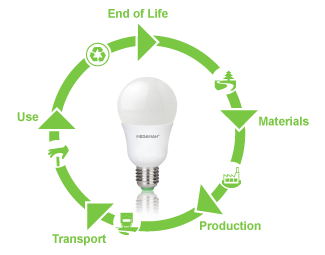Why LED Lighting?
Light Emitting Diodes (LEDs) are the latest and rapid technological advancement in the lighting industry. They are extremely energy efficient and perfect replacement of traditional bulbs with distinct advantages such as exceptionally longer life span (50,000 hours), enormously lower energy usage (85% more efficient), reduced maintenance costs and higher safety. In view of price erosion of LEDs, they are becoming the preferred lighting solution of both general and professional users and widely adopted in different applications.

Efficient
LEDs can achieve energy efficient and consume 85% less power than incandescent bulbs. Since LEDs use only a fraction of the energy of incandescent bulbs there is a dramatic decrease in electricity costs. The long life span feature of LEDs helps achieve even more energy efficiency.
LED lamps have a long life span up to 50,000 hours, which mirrors a stark contrast to an average incandescent bulb having 1,000 hours only. LED lamps will last over 17 years before needing replacement.

Economical
Using LED lamps reduces energy cost, as they use 85% less energy than incandescent bulbs. In real money terms, if a 100W incandescent bulb is used for 1 year, with an electrical cost of 10 cents/kilowatt hour, US$29 will be spent on electricity costs (for 8 hours operation per day). If an 85% efficient LED system had been used, the electricity cost would be US$4 per year. There would be a cost savings of US$25 on electricity during the year.
Long life span of LEDs tremendously reduces labour cost and maintenance cost of replacing bulbs, especially in commercial applications with massive use of LED lamps. Using LED lamps also reduces cooling cost as they generate very little heat, which creates a cooler environment and less electrical energy for air-conditioning.
In the long-run, LED lamps lower the total cost of lighting. As LED lighting technology advances and its supply increases, its prices will continue to drop, making it a more economical option than incandescent bulbs.

Eco-friendly
Unlike most conventional fluorescent lighting bulbs contain large amounts of toxic and polluting materials like mercury, LED lights are free of toxic chemicals like mercury or harmful gases.
Let’s look at the life-cycle of a typical MEGAMAN® LED product. From its design and production stage, to the transportation, usage and disposal stages, every step is carefully engineered to reduce the manufacturer’s and users’ carbon footprints and produce minimal harm to the environment.

For example, MEGAMAN®’s LED lamps are made with recyclable materials such as aluminum heat sink, plastic casting and lamp base, and the production process is highly automated with minimum energy used to produce each component. Recycled papers are used for all packaging materials and no polystyrene is used. When consumers choose to use LED lights, they can reduce the environmental impact as LED lamps are very long-lasting and energy-efficient. The advanced dimming and smart lighting control functions of some LEDs can help people save more energy too.
In support of the Waste Electrical and Electronic Equipment (WEEE), all MEGAMAN® LED products are recyclable due to the materials used in production. Even if the lamps are not properly recycled, they do not lead to land and water contamination. They can also be incinerate for energy recovery or recycled into glue or potting materials or miscellaneous parts.
Moreover, the long life span of LEDs implies saving of materials and production of incandescent light bulbs, leading us to a greener future. Today, most of the energy resources we use are non-renewable. In a few decades or so, we may run out of fuels. Global warming is another pressing problem caused by energy crisis. We can save energy and reduce global warming by using LED lights.


 top
top